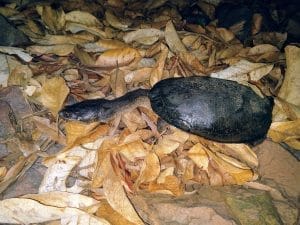Chelodina gunaleni (Gunaleni’s Snake-necked Turtle)
Home > Turtle Database > Chelodina gunaleni (Gunaleni’s Snake-necked Turtle)

Chelodina gunaleni is a freshwater turtle species known for its distinctive long neck and striking appearance. This species, part of the Chelidae family, has garnered attention due to its unique adaptive features and ecological role in its native habitat.
Native To These Regions
West Papua (Indonesia)Native Turtle Species Map – Find Turtles by Region
Scientific Classification
- Kingdom: Animalia
- Phylum: Chordata
- Class: Reptilia
- Order: Testudines
- Family: Chelidae
- Genus: Chelodina
- Species: C. gunaleni
Common Names
- Gunaleni’s Snake-necked Turtle
- Gunalen’s long-necked turtle
This Hilarious Turtle Book Might Know Your Pet Better Than You Do
Let’s be real—most turtle care guides feel like reading a textbook written by a sleep-deprived zookeeper.
This one’s not that.
Told from the snarky point of view of a grumpy, judgmental turtle, 21 Turtle Truths You’ll Never Read in a Care Guide is packed with sarcasm, sass, and surprisingly useful insights.
And hey—you don’t have to commit to the whole thing just yet.
Grab 2 free truths from the ebook and get a taste of what your turtle really thinks about your setup, your food choices, and that weird plastic palm tree.
It’s funny, it’s honest, and if you’ve ever owned a turtle who glares at you like you’re the problem—you’ll feel seen.
Identification
- Description: Chelodina gunaleni features a dark, rugged carapace that can reach up to 30 cm in length. Its most distinctive characteristic is the elongated neck, almost equal to the length of the shell.
- Sexual Dimorphism: Males generally have a thicker, longer tail and are slightly smaller than females.
Check more turtles from the Chelodina genus
Native Origin and Distribution
- Geographical Range: This species is endemic to a small region in Western Australia, primarily found in isolated freshwater systems.
Preferred Habitat
Chelodina gunaleni thrives in slow-moving waters, including swamps, rivers, and permanent ponds where dense aquatic vegetation is abundant.
Behavior
- Feeding Habits: They are carnivorous, preying on small fish, crustaceans, and aquatic insects.
- Predators: Predation mainly occurs in juvenile stages by birds and larger fish.
Reproduction
- Breeding Season: Breeding typically occurs during the rainy season.
- Reproductive Method: Females lay between 4 to 10 eggs in sandy or soft-soiled banks.
Conservation
- Extinction Status: Currently not listed as endangered but is considered rare due to its limited distribution.
- Threats: Habitat destruction, water pollution, and invasive species are the primary threats.
- Conservation Measures: Conservation efforts include habitat restoration and legal protection against poaching and trade.
Economic Importance
The species has limited economic importance but contributes to the local ecological tourism and educational programs focusing on biodiversity conservation.
Interesting Facts
- Chelodina gunaleni can breathe underwater through specialized parts of their cloaca, allowing them to stay submerged for extended periods.
Research Studies
For more detailed scientific insights into Chelodina gunaleni, refer to this research paper: A New Species of Chelodina (Testudines: Chelidae) from Southwestern New Guinea (Papua, Indonesia)

About Author
Muntaseer Rahman started keeping pet turtles back in 2013. He also owns the largest Turtle & Tortoise Facebook community in Bangladesh. These days he is mostly active on Facebook.














